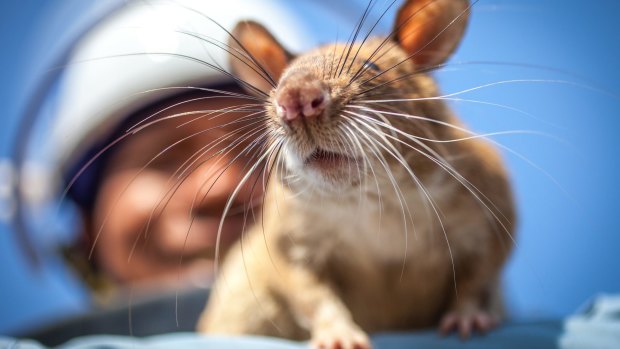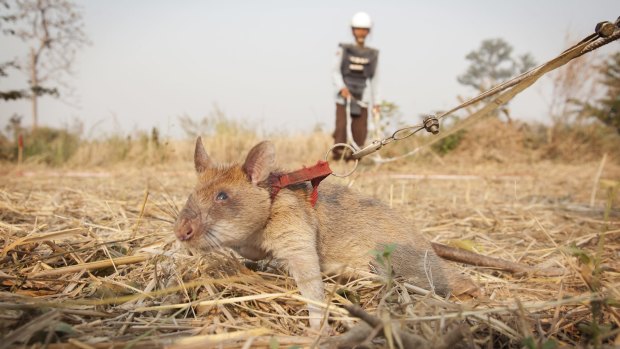This was published 5 years ago
Cambodia, Siem Reap: The giant rats helping to detect unexploded landmines
By Sheriden Rhodes

This industrious and, admittedly, kind of cute rat is an absolute hero.Credit: APOPO
Like most people, save the odd person I'd seen on YouTube (typically wearing black with facial piercings), I'm not a big fan of rats, vermin or rodents – whatever you choose to call them.
Yet watching this giant African pouched rat sniff the dirt and scratch when it has found its target, is another story. See this isn't any ordinary rodent. This industrious, and admittedly kind of cute, rat is a hero.
I'm visiting the APOPO Visitor Centre in Siem Reap where a special forces unit, endearingly nicknamed "hero rats", is helping clear war-torn regions of Cambodia of land mines. APOPO (an acronym that in English means Anti-Personnel Landmines Removal Product Development), alongside the Cambodian Mine Action Centre, is carrying out the humanitarian landmine clearance in the northern Siem Reap. The project returns safe productive land back to mine-affected villages, many of which have lived in fear of explosions for decades.

One of Cambodia's 'hero rats' sniffs for landmines.Credit: APOPO
Centre manager Benjamin Carrichon says an estimated 4 to 6 million landmines were laid in the country, mostly after 1979 when the Khmer Rouge fought against the Vietnamese-backed Cambodian government.
Cambodia has the world's highest ratio of mine amputees per capita with 64,000 reported casualties since 1979. And while casualties have now dropped to record lows, the highly efficient and talented rats have brought fresh hope in terms of ridding the country of landmines for good. "Cambodia was looking for new technology and methodology to speed up their clearance and that's where we came in," explains Carrichon.
APOPO's founder, Belgian-born Bart Weetjens, began training the rats (also known as Gambian giant rats) in Tanzania in 2000 after learning of the enormous issue of landmines in Africa. Weetjens, who had kept pet rats as a child, realised the rats' acute sense of smell could help with fast and cost-efficient removal of mines.
Carrichon says while Diana, Princess of Wales in the '90s put landmines in the spotlight, 65 countries around the world are still dealing with the effects of landmines, including about 900 square kilometres of Cambodia.
In its first year thousands of travellers to Siem Reap, the gateway to Angkor Wat, have visited APOPO's new centre to learn about the issue of landmines, the clearance process and watch a live demonstration of the mine detection rats at work. Carrichon explains that the rats undergo nine months of training to sniff out the chemical compounds of TNT found in landmines and other explosive remnants of war. They ignore scrap metal making them much faster at detecting landmines than metal detectors. "They also don't get harmed themselves as their light weight means they don't set off the explosion," he says.
Wearing small harnesses, the rats indicate where landmines are by scratching the ground. Their handlers (or de-miners) then reward their charges (often with banana), mark the spot on a map and the mines are later collected and safely deactivated.
Carrichon said more than 5000 people last year benefited from APOPO's work in Cambodia. The problem with landmines, he explains, is you can't farm, build or travel safely through impacted areas.
"Even if APOPO can get a tiny trickle of the millions of tourists who visit Angkor Wat just up the road, we can teach how landmines have impacted Cambodia and how we're working to rid the country of a legacy of war that has killed or maimed tens of thousands of innocent civilians."
TRIP NOTES
MORE
At Anantara Angkor rooms start from $291 a night including breakfast. See anantara.com
DO
See the rats in action at APOPO's Visitor Centre, Monday to Saturday, 8.30am to 5.30pm for $US5. Bookings must be made in advance. See apopo.org
Sheriden Rhodes was a guest of Anantara Hotels and Resorts.
Sign up for the Traveller Deals newsletter
Get exclusive travel deals delivered straight to your inbox. Sign up now.